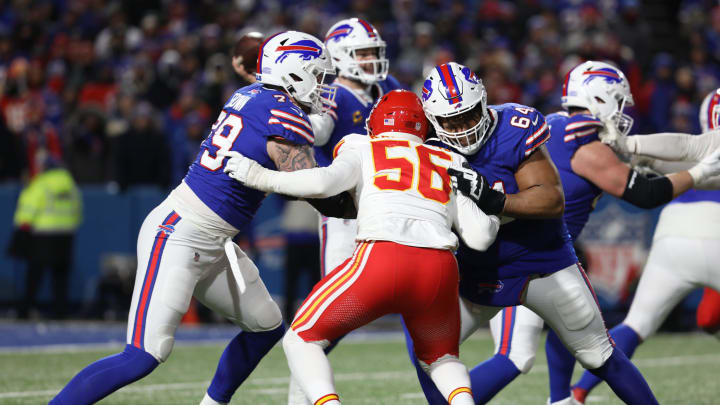Football expert disrespects Bills offensive line with shockingly low ranking

This article was produced in conjunction with Cover 1, a leading voice in making the intricacies of Buffalo Bills football digestible. Be sure to subscribe to their YouTube channel and podcast feeds.
While there has been much discussion this offseason regarding the Buffalo Bills’ offense and how it will change with the departure of Stefon Diggs, there hasn’t been enough talk on another area that has seen changes, as well: the offensive line.
Well-known NFL analytics “guru” Warren Sharp decided to change that discussion for not just the Bills, but for all offensive lines in the NFL, as he recently published his offensive line rankings entering the 2024 NFL season. Buffalo, somewhat puzzlingly, lands at the 22nd spot. While one might think that there is a strong, solid reasoning behind the placement, so far as Sharp is willing to reveal, there isn’t much. The singular blurb from his article says “In third-and-long situations, Buffalo’s offensive line allowed pressure in 2.5 seconds or less at a league-worst 45.9% rate. Without any notable changes to the first-team unit, don’t expect much improvement in 2024.”
ranking the NFL's best offensive lines:
— Warren Sharp (@SharpFootball) July 13, 2024
1. Lions
2. Falcons
3. Browns
4. Eagles
5. Chiefs
6. Jets
7. Packers
8. Colts
9. Bengals
10. Vikings
11. Broncos
12. Bears
13. Rams
14. Texans
15. Chargers
16. Ravens
17. 49ers
18. Raiders
19. Bucs
20. Steelers
21. Panthers
22. Bills
23.…
There’s some strange things said in so few words, so let’s break this down a little bit.
Related: Bills WR Keon Coleman named fantasy football sleeper, compared to 2023 breakout star
Highlighting a very specific data point of third-and-longs doesn’t really say much. On the one hand, someone may argue that a good offensive line wouldn’t get themselves into a large number of third-and-longs, and if they do, they should be protecting better than that. This reasoning paints a bit of an incomplete picture, however, as it doesn’t account for anything that is outside of the offensive line’s control (penalties, play calls, quarterback decision-making, running back decision-making, etc.). This is also not to denigrate either James Cook or Josh Allen, both of whom had fantastic 2023 seasons; this is only to say that highlighting this particular point of data (without elaborating much on it) isn’t a good analysis of the situation.
The Bills' starting offensive line has undergone several notable changes this offseason, the biggest of which being the departure of stalwart center Mitch Morse as a cap casualty. They also traded a versatile backup in Ryan Bates to the Chicago Bears. Choosing to stay in-house in terms of solutions, the Bills are bumping 2023 starting left guard Connor McGovern into the starting center spot, with last year's "jumbo set" lineman David Edwards figuring to replace McGovern at guard.
On top of that, the Bills spent several of their day three picks on offensive linemen, including Georgia center Sedrick Van Pran-Granger. While he may not start this year, Van Pran-Granger may fit into the Bills’ future offensive line plans. Regardless of that, having a new center playing for Allen is a big deal, and both McGovern and Edwards provide a new tool for the Bills on the offensive line that hasn’t been available to them with some of their previous players: length.
Read More: Buffalo Bills' Round 5 Draft Pick: Fun Facts about Georgia C Sedrick Van Pran-Granger
Shifting McGovern to Center and placing Edwards at Guard brings a key advantage: arm length. While Morse had 32 1/4 inch arms, McGovern boasts 34 1/8 inches, and Edwards has 33 1/8 inches.
— Erik Turner Cover 1 (@ErikJTurner) July 9, 2024
This added length benefits the O-line significantly, aiding in both pass protection and…
This is a key to offensive line play in general, or at least a tool that coaches like their players to have. More than that, it hints again at the Bills wanting to commit more to running the ball in 2024 under new offensive coordinator Joe Brady. As Erik Turner points out in the tweet above, the push and extension that a lineman can get with his arms allows for more separation at the point of attack, allowing the linemen better handling and leverage of the defender they’re blocking.
Related: Bills WR Keon Coleman reacts to Josh Allen's incredible golf shot: He's 'unreal'
This is all to say that the notion that Sharp asserts in his article that there isn’t much change on the Bills’ offensive line is a misconception not supported by facts. Not only is there change across the unit, but the change that is there is significant and signals the philosophical change on offense that has been expected with Joe Brady at the helm.
If there is more to Sharp’s rankings, it would be great to hear or see them. However, given that it’s notoriously difficult to develop good, consistently strong offensive line stats (ESPN’s block win rate, and adjusted line yards from FTN’s DVOA group being the exceptions) it’s hard to imagine Sharp developing anything that holds water. While block win rate and adjusted line yards are both solid pieces of the puzzle, when it comes to offensive line play, it’s going to require a lot of tape study and knowledge of blocking schemes and techniques. Resources such as Duke Manyweather and Brandon Thorn are very helpful in learning about offensive line play. Their Substack Trench Warfare is one of the best places to learn about the subject.
Sometimes it’s simply easier to separate the chaff from the wheat. That is to say, learn who to listen to and who to ignore when it comes to certain subjects. While Sharp has many useful tools and brings great analytics to the table of football discourse, his opinions on what constitutes good offensive line play do not merit much concern.
— Enjoy free coverage of the Bills from Buffalo Bills on SI —
